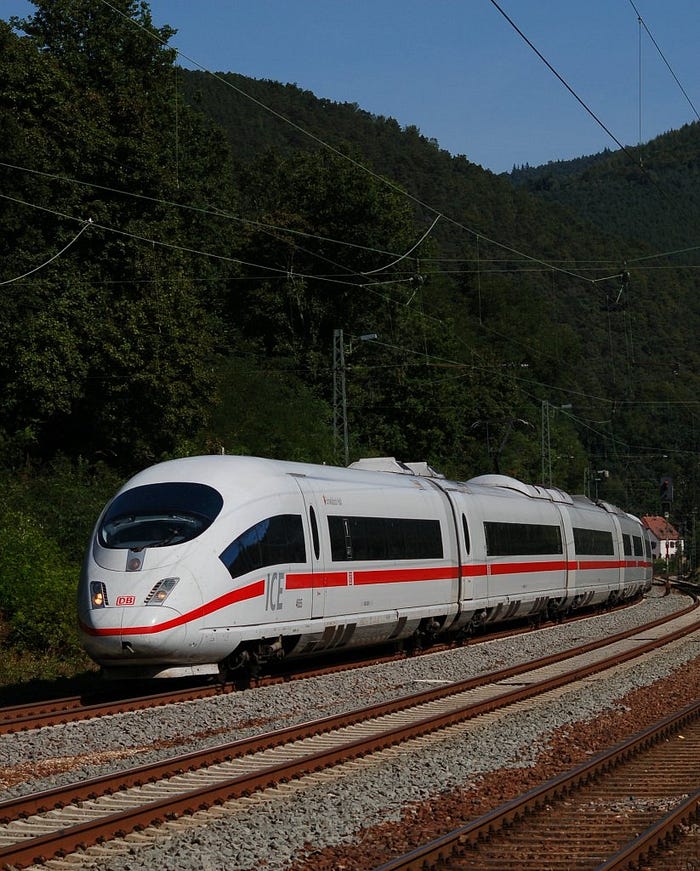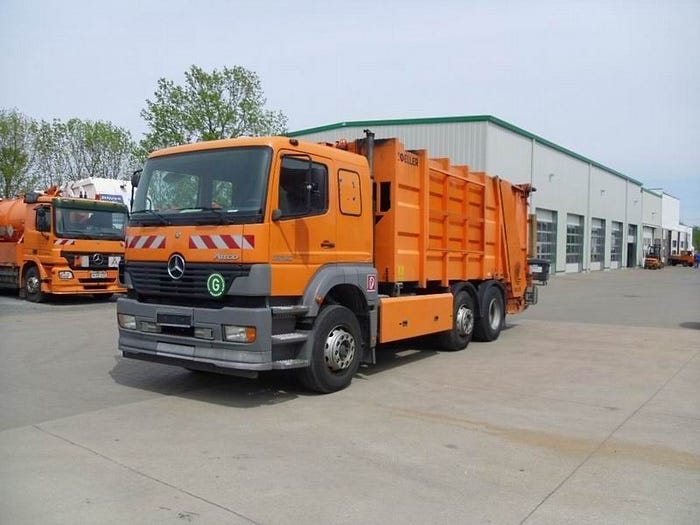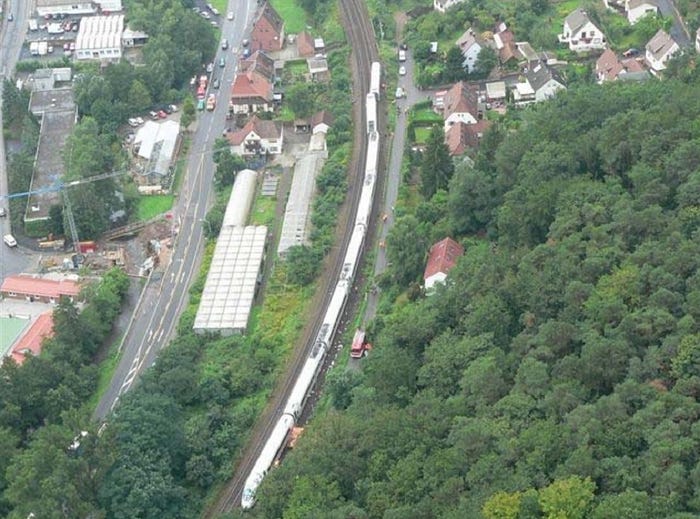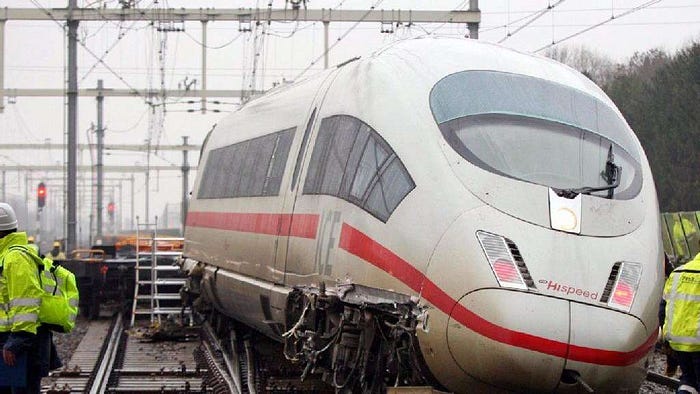
Background
Lambrecht is a small city (population: 4050 as of December 2019) in the far southwest of Germany, 30km/18.5mi southwest of Mannheim and 40km/25mi north of the French border just west of Karlsruhe.

Running through the city from east to west as part of a large S-curve is the the Mannheim-Saarbrücken Railway, a 130.5km/81mi double-track electrified mainline opened in full in 1904 the railway is an important corridor for long distance freight and passenger service, including international high speed connections to France with the French TGV or the German ICE trains. Due to the age of the railway it was largely adapted to the landscape (rather than going as straight as possible with large bridges and tunnels), leading to a relatively slow speed which only reaches 200kph/124mph in a few sections while others are limited to as little as 80kph/50mph.

The vehicles involved
Travelling westbound as ICE (Intercity Express) 9556 from Frankfurt to Paris was ICE number 4681 (coded Tz 4681), an 8-car ICE 3 MF introduced in July 2006. The ICE 3 MF is a special version of the third Generation Intercity Express, Germany’s high speed train, for connections between Frankfurt and Paris. MF stands for “Multisystem France”, setting the trains apart from both standard ICE 3 and Multisystem-versions which cannot go to France (lacking the “F”). The trains, internally designated series 406, feature several changes, including a second electrical system, an emergency kill switch for the driver which only has to be hit (like a big button) and metal hooks on selected tables to restrain unruly passengers. Tz 4681 had actually been the train used for the first scheduled connection to Paris in 2007.

Opposite to the first two generations the ICE 3 does away with a dedicated motor car, the entire drive train is distributed throughout the train, holding 16 motors in 4 powered cars. This allowed the installation of lounges in the end cars where passengers can look over the driver’s shoulder (through a pane of glass which the driver can turn opaque at will). An ICE 3 MF weights 435 metric tons empty and can hold 425 passengers in a two-class configuration at 200.84m/ft long. Reaching up to 330kph (320 in service, on French high speed routes) makes them the fastest ICE-trains.

Driving westbound through the part of Lambrecht located north of the railway was the garbage truck from a local private recycling company on it’s regular route to collect the residents’ trash. The company used a six-axle truck weighting approximately 11 metric tons empty. On board were a 35 years old driver and his coworker riding on a running board at the back, responsible for hooking up the trashcans to be emptied.

The accident
On the 17th of August 2010 at approximately 9:55 Tz 4681 has recently left Mannheim main station behind and is now travelling westbound through the federal state of Rhineland-Palatine with 320 passengers and crew on board. The train is technically running in reverse (not that there is a difference between the ends except for reversing the order of second- and first class cars), being controlled from the first class end car 406 081–0. Around the same time a garbage truck finishes collecting the resident’s trash in the Dörrentalstraße, a small residential dead-end road on the northwestern edge of Lambrecht. There is a small underpass connecting the street with Lambrecht itself, but due to the height of the truck the driver is forced to take a detour to the east to a larger underpass. Rebuilding the smaller underpass to fit the trash truck had been declined by the city due to cost, as had the acquisition of a smaller garbage truck for the few houses in that part of the city. As it stands the truck turns left into the Lambrechter Straße (Lambrecht Road), a small single-lane road with a soft (grass) shoulder on the southern (right hand) side.

It’s a clear and sunny day, after some rain in the previous night. A few meters down the narrow road, which barely accommodates the truck, the driver for moves his right hand wheels off the tarmac onto the grass. The wet soil cannot hope to hold the weight of the truck and gives way. The coworker on the back manages to jump off onto the road, but the driver is caught in the cab as the truck falls over, down a 2.5m/8ft embankment onto the track. Suffering severe injuries in the fall the driver realizes his dangerous situation and manages to abandon his truck, climbing back up the embankment. Moments later the ICE rounds the corner at 99kph/61mph. The driver of the ICE triggers an emergency stop at 10:06:18am, desparate to shave off at least a few kph. 4 seconds later the train has dumped pneumatic pressure, applying full brakes. The train strikes the truck head on (but not at full width) at 10:06:25, travelling at 81kph/50mph. The train obliterates the driver’s cabin of the truck before being deflected off the track, with part of the compactor-system getting stuck in the side of the leading car. The wreckage of the truck slices down the length of the leading car and destroys the forward doors/entrance area of the second car before the train separates from it. The leading car derails entirely, with the forward axles leaving the track to the right, while the second car heads to the left, blocking the oncoming track. The LZB (signalling/train control system) antenna is destroyed, registering conflicting data. Regardless of that an emergency signal is sent out, ensuring no oncoming train will run into the derailed ICE. 16 seconds after the impact the ICE stops 208m/682ft behind the point of impact. In addition to the truck driver 15 passengers, the train driver and 2 members of the train’s staff are injured, 7 of which severely (excluding the truck driver).

Aftermath
Alarmed by residents living near the site and people on the train, as well as the train driver’s radio call to dispatch responders arrive within minutes of the collision. They’re met with an impressive, yet somewhat frightening sight. A massive 20cm/7.87in wide gash runs down the entire length of the leading car, it looks like someone used a giant can-opener to release some anger on the train. The truck was completely destroyed in the collision, but with both employees of the recycling company being met by responders up on the road the focus is on the evacuation of the passengers and treating injuries, rather than worrying about the remains of the truck.


7 passengers and the truck driver are taken to the local hospital, with the remaining crew and passengers being taken to Mannheim with several buses and continuing their trip to Paris from there with a replacement train. With the (brief) investigation on site finishing early the next day the DB (German national railway) brought in cranes to re-track the ICE, before a pair of special recovery-locomotives (fitted with the Scharfenberg-coupler, which usually doesn’t come on locomotives) towed the train away, storing it for the time being. The damage to the track and signaling-system was repaired the day after that, and the line reopened on the 20th of August.

With the investigation wrapping up the DB scrapped the severely damaged forward two cars, leaving the remaining 6 in storage until, in January 2011 another ICE had a collision with a freight train in the Netherlands. The damaged cars were replaced with ones from Tz 4681, officially dissolving the train and removing it from fleet lists.

In the meantime the report placed full blame on the driver, as the investigation concluded that he had been going too fast on the narrow road, causing him to fail to keep all wheels of the truck on the tarmac. The driver was sentenced to a fine of 2250€/2736 USD for negligent driving and speeding. Shortly after the sentence was announced the DB sued him for the 12 million Euros (15 million USD) damage (the train, track, cancelled trains, replacement trains and buses, delays). After a lengthy court-battle an agreement was published in January 2013. The truck driver doesn’t have to pay himself, half the sum will come from his employer’s insurance, 2.8 million Euros (3.4 million USD) is paid by the municipality and the rest by the DB’s insurance. According to the judge both the municipality and the DB carry partial fault, failing to ensure that the small road is sufficiently secured against vehicles ending up on the track. Part of the argumentation was the needless detour the truck has to take, but also past accidents on the narrow street including one where a car had ended up on the track (without being hit by a train). After the accident the road was widened, eliminating the soft shoulder, and guardrails were added.
With the introduction of the new series 407 “Velaro” trains in 2012 (an “ICE 3.5” if you will) there was no more demand for the ICE 3 MF, leading to the remaining 5 units had their modifications for connections to France removed, re-enabling them to travel into Belgium.

_______________________________________________________________
